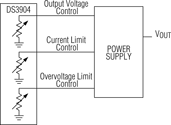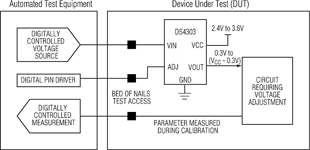
Digital potentiometers, or digipots, facilitate digital control and adjustment of resistances, voltages, and currents in analog circuitry. Common applications include power supply calibration, audio volume control, brightness control, gain adjustment, and control of bias and modulation currents in optical modules.
Beyond basic digipot specifications, there are a number of features that can improve system performance and simplify designs. Among these features are various types of nonvolatility, zero-crossing detection, debounced pushbutton interfaces, temperature compensation, and write protection. The relevance of each of these features varies with the application.
A true potentiometer is a three-terminal device (Figure 1a). The low terminal, VL, is either internally-connected to device ground or pinned-out for design flexibility. This three-terminal digipot configuration is essentially an adjustable resistive divider with a fixed end-to-end resistance. A variable resistor is a two-terminal digipot variant, with the wiper internally-connected to one side of the potentiometer (Figure 1b). Adjusting the position of the wiper in a variable resistor digipot configuration effectively modifies the end-to-end resistance of the digipot.

Put simply, a digipot is an analog output, controlled by a digital input. This description is similar to the definition of a digital-to-analog converter (DAC). Unlike DACs, which provide a buffered output, most digipots are not intended to drive low impedance loads without an external buffer. Depending on the digipot, maximum wiper currents range from the hundreds of microamps (μA) to milliamps (mA).
Always ensure that under worst-case conditions, the wiper current will remain within the allowable IWIPER range when connecting a digipot wiper to a low impedance, regardless of whether a variable resistor or a true digipot is used. The worst-case wiper loading for a variable resistor occurs when VW approaches VH. At this point there may be little resistance in the circuit, other than the wiper resistance, to limit the current. However, there are some applications where the wiper current is inherently large. Under these conditions, the voltage drop across the wiper should be taken into consideration, as this drop limits the digipot output's dynamic range.
Usage
Circuits employing digital potentiometers vary widely. In some cases it may be necessary to 'fine tune' the digipot for a specific application by adding external components. As an example, common end-to-end resistance values for digital potentiometers range between 10 kΩ and 200 kΩ. However, when controlling LED tile brightness, a much lower resistance is often required. A novel solution to this problem is found within the DS3906, which provides effective resistances between 70 Ω and 102 Ω when placed in parallel with a fixed 105 Ω resistor. The 0,5 Ω step size in this configuration allows precise adjustment of LED brightness.
In other cases a digital potentiometer with more specialised features may be the key.
Applications that require temperature-compensated voltages or currents, such as laser driver biasing in optical modules, benefit from lookup-table-based variable resistors. Parts are available that include an internal EEPROM that stores thermal calibration lookup data in temperature increments. An internal temperature sensor measures the ambient temperature. The digipot then adjusts the variable resistor using the modifier in the lookup table that corresponds to the measured temperature. Thermal-lookup-table-based digipots typically either correct for a nonlinear temperature response of a circuit element, such as a laser or a photodiode, or intentionally create a precise, nonlinear resistive temperature response that is specific to an application.
Nonvolatility is a common and inexpensive add-on feature for digital potentiometers. Standard EEPROM-based nonvolatile (NV) digipots power up into a known state during power-on-reset. EEPROM technology easily guarantees 50 000 write cycles, which is a significant reliability upgrade when compared to mechanical potentiometers. One-time programmable (OTP) digipots, such as the MAX5427-MAX5429, permanently store the default wiper position using fuse programming. As with EEPROM-based digipots, after power-on-reset, OTP digipots initialise to a known state. However, the power-on-reset state of an OTP digipot cannot be rewritten once programmed. Consequently, OTP is well suited for factory or production calibration.
While fuse-programming permanently sets the POR wiper position for OTP digipots, it does not necessarily lock the wiper position. The wipers of many OTP digipots are fully adjustable after fuse programming. In other OTP digipots, the wiper position is permanently set, resulting in a precise, calibrated resistor divider. Some digipots offer a lockout register, or a digital control input, that tri-states the digipot interface, preventing inadvertent wiper adjustment. Disabling write capability in EEPROM digipots also reduces power consumption.
Other advantages
Digital potentiometers can also aid the automation of voltage and current calibration in power supplies or other systems that require factory calibration. They can increase manufacturing throughput, and improve calibration accuracy and repeatability when compared with more time-consuming and inexact manual calibration using mechanical potentiometers or discrete resistors. In addition, digital control of the potentiometer facilitates remote debugging and recalibration when desired. In systems where multiple voltages and/or currents are calibrated, digipots such as the DS3904/DS3905 triple NV digipots are ideal (Figure 2).

In this case one small IC can replace up to three mechanical potentiometers. Layout flexibility increases when digipots replace mechanical pots, as the digipots need not be readily accessible to technicians for calibration during assembly or rework. Calibration is a prime example of an application where OTP or EEPROM write-protection is desirable, and EEPROM write-protection can be useful as well.
Although not a digital potentiometer, a sample-and-hold voltage reference such as the DS4303 with a simple one-pin digital control interface can provide similar production calibration functionality in a more compact space also useful for production calibration (see Figure 3). During calibration, its output samples an applied input voltage until locked by the control input. After the output is locked it will not change until reprogrammed or until power is removed, regardless of the voltage applied at the input. The most recently latched output voltage is stored in EEPROM, and is restored after power cycling.

Evolving pushbutton interfaces complement traditional serial interface offerings such as SPI, I²C, increment/decrement, and rotary control. One such interface is used in the MAX5457. This debounced pushbutton interface advances the wiper at varied rates, depending on the duration of the button press. Pushbutton interfaces do not require a microcontroller, and hence reduce the system complexity. Debounced pushbutton interfaces are particularly useful for audio volume adjustment.
Digipots targeted at audio applications often feature zero-crossing-detection circuitry. Zero-crossing detection reduces the audible clicks and pops that can result when the wiper transitions from one setting to another. When active, zero-crossing detection delays wiper transitions until VL is approximately equal to VH. Many zero-crossing-detection circuits also feature a maximum wiper-transition delay to facilitate DC applications and other specialised circuits.
Simple volatile digipots remain useful in system design, but application-targeted digipots and variable resistors offer added functionality. Whether replacing mechanical potentiometers, improving system reliability or performance over temperature, eliminating a need for a system microprocessor, or reducing audible clicks and pops, digipots add value. Whatever the application there is a suitable digipot.
| Tel: | +27 11 458 9000 |
| Email: | [email protected] |
| www: | www.electrocomp.co.za |
| Articles: | More information and articles about Electrocomp |
| Tel: | +27 11 608 0070 |
| Email: | [email protected] |
| www: | www.cstelectronics.co.za |
| Articles: | More information and articles about CST Electronics |

© Technews Publishing (Pty) Ltd | All Rights Reserved